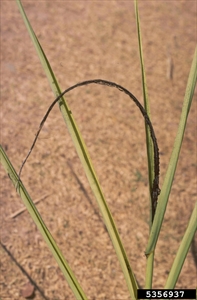- Worldwide distribution. In Australia; note, report from Fiji incorrect.
- Serious disease, often occurring in cycles: epidemics followed by minor importance. Infected plants weak, grass-like, stunted with narrow leaves and many tillers. Characteristically, shoots become black spores-bearing whip-like structures.
- Lower buds infected by fungal spores from soil. Subsequently, sets planted and fungus grows within them.
- Spread: infected sets and spores on the wind. Possibly, spores on machinery, footwear. Survival in soil for 3-4 months.
- Biosecurity: follow FAO guidelines for international movement of sugarcane.
- Cultural control: deep ploughing or irrigation of fields after outbreaks; hot water treatment (52oC for 30 minutes or 50oC for 3 hours); rogueing.
- Chemical control: fungicides (flutriafol or propiconazole) after hot water treatment in commercial operations.







